This latest blog features a cracking day out at Frampton Marsh where we reached the magic Big Year total of 300 again, and an incredible day's birding at Flamborough Head. Lots of content from those two days means that the bulk of my birding in October, based around a whole week's holiday in Cornwall gets its own blog entry here.
This time next year, I'll probably be writing up October 2024. I need to retire.
Saturday 7th October; Frantic Frampton!
The amazing RSPB reserve of Frampton Marsh on the Lincolnshire side of The Wash, was on fire. It had been teeming with birds of late, most notably scarce waders such as Semi-palmated Sandpiper, Buff-breasted Sandpiper, and Lesser Yellowlegs. There was also a Lapland Bunting that had been around for a week or so as well. We only needed two more species to reach our Big Year target of 300 birds seen in the year, an achievement reached the year before but not until the last week of December. This time we were likely to reach the total in the first week of October, testament to a greater effort on our part this time but also a reflection on more bird species being seen in the UK during 2023, and many of them closer to home so easier to go and see during the working week.
Predictably the carpark was rammed when we arrived just after eight o'clock. We spotted our lucky friend, Kev's, car parked up already, so we knew we'd be in for a good day. Kev doesn't miss too much and was on a Big Year quest of his own, indeed he'd already reached 300 for the year. Kyle, his partner in crime, is also good at attracting the birds so we couldn't miss. I checked for the latest sightings as we left the carpark. The Buff-breasted Sandpiper had already been seen, I could see a gaggle of birders draping the seawall in the distance so guessed that was where that bird was. When we started out from the carpark there had been no call on the Semi-palmated Sandpiper, although I assumed it would still be around so it was just a matter of time before one of the many birders on site found it.
Typically by the time we had reached the seawall, the Semi-palmated Sandpiper had been found again so we now had a dilemma whether to track back to the 360 hide from where it had been seen or to carry on to where the Buff-breasted Sandpiper was. We noticed quite a few of the birders had already decided to leave the latter bird in order to see the former. Neither bird would be a lifer, I was merely hoping for better views and photos of both species than I'd achieved before. The only Semi-palmated Sandpiper we'd seen before was at Titchwell Marsh on the opposite side of The Wash in 2019 and that was distant and viewing had been into the sun. On that day we had taken in a visit to Frampton Marsh as well, the star bird there being a White-rumped Sandpiper on that occasion. Realising that there would likely be a rush and a crush to access the 360 hide we decided to take it easy and continue on our stroll towards the Buff-breasted Sandpiper. That's about as cool as I get.
We met Kev and Kyle, who were already watching the Buff-breasted Sandpiper, the second we'd seen this year after the one at Saltholme a few weeks before, but unlike that one which was a hundred metres away, this one was showing extremely nicely just metres away from the fence at the bottom of the seawall. I got myself into a decent position and gained some nice shots of the bird set amongst the autumnal colours of the vegetation of the marshland. All the time though, I was restless, knowing that there was a rarer bird just a few hundred metres away that I didn't have any good photos of in my portfolio, so we didn't stay long but joined the mass exodus towards the main reserve.
Predictably the 360 hide was rammed and it was standing room only. The mood within the hide was strained to say the least, as birders jostled for views out of the hide windows. The Semi-palmated Sandpiper was showing, but by all accounts was fairly distant, out of the northern side of the hide. I couldn't see it but bided my time. As I always try to do, I managed to find a spot for Mrs Caley to sit down, unfortunately at a window which faced the wrong way but she was able to look to her left side towards where the rare Sandpiper was. I stooped to get views out of the hide between the heads and shoulders of others. Eventually I got a sneaky view of the bird as it fed alongside a small pool of water about fifty metres out from the hide. Not much of a view but marginally better than the one I'd got of my first Semi-palmated Sandpiper at Titchwell a couple of years before.
Now that the bird had been pinned down, I was able to get Mrs Caley on to it so we relaxed a bit, a lot in fact. There was still a lot of taut people in the hide since many had yet to see the rare Sandpiper. Slowly that tension dissipated as all who wanted to see the bird were shown where to look. The flock of Dunlin that the Semi-palmated was part of, took to the air several times but after wheeling around always landed back in the same vicinity. Once studied it became easier to pick the smaller bird out of the throng, the shorter bill and clear white supercilium were useful markers.
The hide was clearing out, folk who had seen the Semi-palmated Sandpiper were making their way to catch up with the Buff-breasted sandpiper that we had already seen. We gained a better seat at the windows with a straight on view of the wading bird flock. The hide became calmer too, now that the most stressed of folk had left, and the dozen or so of us left in the hide were treated to much better views of the birds since, probably emboldened owing to the noise dissipating somewhat, they all slowly approached the hide and fed upon the rich mud. I was able to grab some illustrative photos for my portfolio.
When the flock hit the air again, I fired off a volley of shots, not aiming at any particular bird, that would have been impossible anyway, but hoping to capture the Semi-palmated Sandpiper. I spent a while that evening sifting through the photos and relived the experience of picking the target wader out amongst the Dunlin. At least one of the half-dozen Little Stints was in a couple of the shots as well. Taking photos allows the observer to see more than they'd be able to in real time especially when observing flying birds.
The flock had seemingly flown off so we exited the hide as well. It was a dull grey day and if anything the light had become even gloomier. Where the path to the 360 hide meets the main track by the reedbed hide, a small group of birders were congregated. At Frampton Marsh it always pays to inquire what people are looking at since there can be so much to see at the reserve, and it's impossible to find it all yourself. The group were watching the Lesser Yellowlegs that we knew was present but hadn't seen yet. We'd already listed the species for the year when we'd got one at distance in the rain at Goldcliff a few weeks before. This bird wasn't very close either, certainly not for photography, but the scope views were good.
 |
| Lesser Yellowlegs |
We headed back to the seawall. There was still a throng of birders watching the Buff-breasted Sandpiper which was possibly showing even better than it was earlier. I couldn't resist stopping and taking more photos.
The bird we really wanted was a Lapland Bunting which had been seen a number of times over the preceding fortnight or so. It was generally on a small area of dry marsh just a hundred yards or so past where the Buff-breasted Sandpiper was. Because of the presence of the scarce wading bird, which was hogging all the attention, nobody else was bothering to look for the Lapland Bunting. We set up at the correct point and zoned into the task in hand. I found a small flock of Linnets and then some Meadow Pipits and a couple of Yellow Wagtails. There were Reed Buntings feeding amongst the short grasses too. Then Mrs Caley spotted something and asked me her usual question, 'What's this?' I followed her guidance and found the bird that she'd seen, It was the Lapland Bunting! Three hundred was up for the year. Just a shame that I couldn't secure a photo to commemorate the milestone. The Lapland Bunting was pretty mobile but we both watched it for a while before it flew over our shoulders and onto the salt marsh.
Wrapping up the Big Year for the second successive year put the icing on a really good days birding at one of the best reserves anywhere.
Year List additions;
299) Semi-palmated Sandpiper, 300) Lapland Bunting
Saturday 28th October; Fabulous Flamborough & More!
For our first outing since our less than glorious holiday to Cornwall, we travelled to Flamborough Head, and to North Landing in particular, to twitch a first for Britain which had been found the week before (as we'd driven home from the south-west) and had stayed true to a hedgerow and adjacent field since. Our friend Ewan had been able to go the day after the bird was found and gained some incredible photos (see Black Audi Birding) but since then the farmer who's land the bird was on, had denied access to the original field which had allowed for close views of the hedgerow, so viewing was now from another field edge where views would be more distant. However, it was clearly a bird worth seeing, so we went to try our luck.
The whole Flamborough Head promontory is a fantastic spot for scarce and rare birds but at almost a four-hour drive from home it's not a place we visit that often. In fact we hadn't been back to the area since we twitched a Red-tailed Shrike at Bempton Cliffs at about the same time the year before. We've seen plenty of other terrific birds at Bempton and Flamborough, most notably the Black-browed Albatross that spent three summers camped out in the Gannet colony at the RSPB's Bempton Cliffs reserve.
This was a popular twitch. At least twenty other birders were already at the carpark when we arrived and we could see others making their way around the clifftop path to join more that were stood at the viewpoint. I spoke to a chap who had returned from seeing the Bunting and got the details of how to get there although we could have just chosen to follow everyone else. The walk was long, probably a good mile or so, and the last quarter of a mile was through thick mud, luckily we had donned our wellington boots, but it was slippery and treacherous in places. We found a place in the line of maybe forty birders, got the gen from the chap stood next to us, and watched the spot where the bird had last showed. Ten minutes later I spotted the head of the Red-headed Bunting (which wasn't red), poking up from a bramble bush. I spent the next ten minutes trying to point out the bird to everyone stood around me, but it seemed as if you had to be stood in the right place to actually see it. The Red-headed Bunting became the 421st bird on my UK life list. My initial attempts to photograph the bird failed miserably.
A passing Kestrel sent all of the birds into cover and we never saw the Red-headed Bunting for another half hour. When it was spotted again, it favoured a particular part of a rough bramble hedge which it shared with Yellowhammers and Reed Buntings. The feeding spot was a stubble field the other side of the hedge. There was a small pond and rough area of grass between us and the bird so we were probably around fifty metres away. The stubble field was where the early twitchers had been able to access to get their brilliant views a week before. The Red-headed Bunting was a first-winter bird so lacked the actual red head, and was all over a very pale sandy colour so when it did pop up on the fence it blended in with the straw in the background. The Bunting also tended to face away from us when perched which made it even more difficult to get good views and to ensure that the camera was pointing at the right bird.
We stayed another half hour or so, during which the Red-headed Bunting showed maybe five times for maybe thirty-seconds on average. Plenty of time to take a whole series of rubbish photos! The best of the few that didn't end up binned are shown here.
While we'd be watching the Red-headed Bunting, news had been arriving via the usual sources of a bit of a jamboree at Flamborough Head. Various scarce Warblers had been reported including a Two-barred Greenish Warbler, plus an Alpine Swift had been seen. As we trudged through the mud back to the car, my mate Jim texted to tell us that he was filling his boots at Flamborough and was now on his way to snare the Red-headed Bunting. I replied,'Snap!' and that I'd just seen the Bunting and was now on my way to Flamborough. Great minds think alike, even if they do it in opposite directions.
We arrived at Flamborough Lighthouse carpark which was busy as it always seems to be. Last time we were here, it was to year tick a Woodchat Shrike which proved to be very elusive. As we walked towards the sea we could see a huddle of birders watching the nearest end of the "Motorway Hedge", a well known row of bushes that attracts migrant birds regularly. I asked a chap who was returning to the carpark what was about and he told me that the Two-barred Greenish Warbler was along the hedge and that a Dusky Warbler was in the ravine below the lighthouse. Further to that there were also Pallas's and Yellow-browed Warblers out on the scrubby clifftop. Phew, that was a lot of birds to try and catch up with!
We joined the end of the group of birders, assuming that they were watching the Two-barred. I heard someone say, 'There it is, by the fencepost'. I looked and found a bird. It wasn't a greeny-yellow warbler though but rather a dull brown bird with a prominent buff supercilium. I was looking at a Dusky Warbler!
I got Mrs Caley onto the bird which was affording decent views. Dusky Warblers are well known for being extreme skulkers, only occasionally showing as they grub out food in bushes and long grass. This one was in view almost constantly as it moved through vegetation at the foot of the hedge. I fired off some photos, not gaining brilliant results because we were thirty metres away, but it was good to get images of the whole bird instead of just bits!
I've always liked Dusky Warblers since seeing my first in Suffolk pre-millennium. In our early years of birding we saw a couple of really showy Dusky Warblers, one at Kessingland, also in Suffolk, gave outstanding views down to just feet at times but of course that was in the days of no cameras. How I'd love to get an opportunity like that again.
The Dusky Warbler moved away out of view so we walked along the fence, noting many Chiffchaffs in the hedge. Another smaller huddle of birders were watching another group of bushes, where the Two-barred Greenish Warbler had been seen but not for half an hour or so. There were also birders watching a patch a bramble about fifty metres away. The cause of that interest was because of the presence of a Pallas's Warbler which was already on our year list after we saw the bird at Attenborough in February. So we had to make a decision of whether to wait it out for the Two-barred to show or go and see the enigmatic Pallas's. However, Pallas's Warblers are amazing little birds to watch, but usually devils to photograph since they move so quickly, and I wanted to take my chance at securing a decent photo or two so we chose to "go for that" first. We located the bird immediately but it gave us the runaround for the next fifteen minutes and was always a second ahead of me, resulting in me getting loads of shots of bramble twigs and leaves! Eventually I managed to get a photo of the bird but not what I'd hoped for. I think Pallas's Warblers are just about the hardest bird to capture on camera. They really are the quickest and most erratic mover of all the birds I've seen.
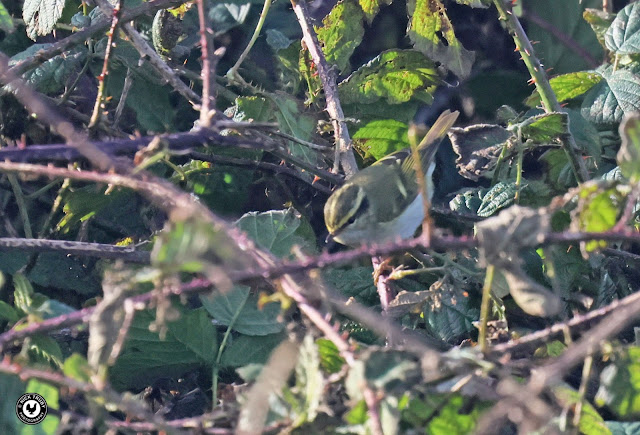 |
| Pallas's Warbler |
Two-barred Greenish Warblers are larger than Pallas's Warbler, still small but more Chiffchaff sized rather than Goldcrest. Consequently they move a bit slower as well as being a bigger target so are much easier to photograph. That is my judgement made purely on my huge sample size of two of course! Thus I managed to get some decent images of the Two-barred, much better than I had got of the Pallas's. The bird at Spurn did show better though (see those pics here).
Lunch was taken at the lighthouse cafe which was pretty hectic so it wasn't exactly a relaxing break. Mrs Caley was feeling a little unwell too, she'd worsen the next day with covid type symptoms, which I myself then picked up a week or so later. At the time we didn't know that of course so while she sat in the car because she'd run out of energy, I went back out onto the headland to try again for photos of the Pallas's Warbler. I found it readily enough, I only had to follow the birders, but knew I didn't have long. My efforts were slightly better than before although those pesky leaves and twigs put paid to any really good photos and the Pallas's was very fond of showing its backside to the camera. It was fun trying to get the shots though and I did capture all seven stripes plus the yellow rump in a couple of blurry efforts.
The rest after lunch had done Mrs Caley some good and she felt well enough for us to travel down through East Yorkshire to reach a place called Stone Creek on the northern bank of the River Humber not far from Hull. We were there primarily to see a Rough-legged Buzzard that had been present for a few weeks. The road to the site was long and straight and the flat farmland either side didn't promise too much but of course, birds see the land differently from us and the last two fields were exactly what the Rough-legged Buzzard, as well as other Birds of Prey, wanted. We spotted the rare Buzzard, only perhaps the fifth that we'd seen, hovering high above one of the stubble fields but a fair way off.
I moved our car to a closer vantage point from where we could access a public footpath that ran towards the seawall. We walked about halfway so that we were right in the midst of the action, so I thought but of course the birds see us better than we see them. We'd also seen a couple of Hen Harriers by that stage so there was plenty to keep us occupied. Initially it was the Rough-legged Buzzard that I was keen to photograph, I'd only ever managed to get distant shots of one before. However, unsurprisingly the closeup views that I sought didn't materialise, but we did get excellent scope views of the Buzzard as it hovered and also when it perched in bushes next to the seawall.
I had slightly more luck with the Hen Harries which quartered the same field and occasionally flew past close enough for some better shots to be obtained. The Harriers, like the Buzzard were a year tick, making it five new additions on the day.
As the sun began to dip towards the horizon, the opposite field to the other side of the path, livened up when a trio of Short-eared Owls and a couple of Barn Owls appeared and hunted. The Shorties in particular made several close passes to where we stood. It's always good to see hunting Short-eared Owls.
As well as all that, a Merlin bombed past a couple of times, chasing the Goldfinch flock, but predictably I got no photos of that one. I never get photos of Merlins. A Marsh Harrier over the seawall, several Little Egrets and a Great Egret going to roost, and a flock of five hundred or more Golden Plover brought down the curtain on an amazing bird filled day. Probably the best land based day of the year!
Somehow we'd managed to miss Jim despite us seeing the same birds and visiting the exact same spots. Until we sat in Trowell services having a coffee when Jim sauntered past. It's a small world indeed where like-minded people hang out!
Year List additions;
303) Red-headed Bunting #421, 304) Dusky Warbler, 305) Two-barred Greenish Warbler, 306) Rough-legged Buzzard, 307) Hen Harrier








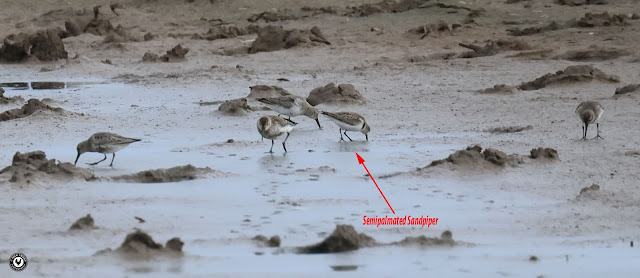




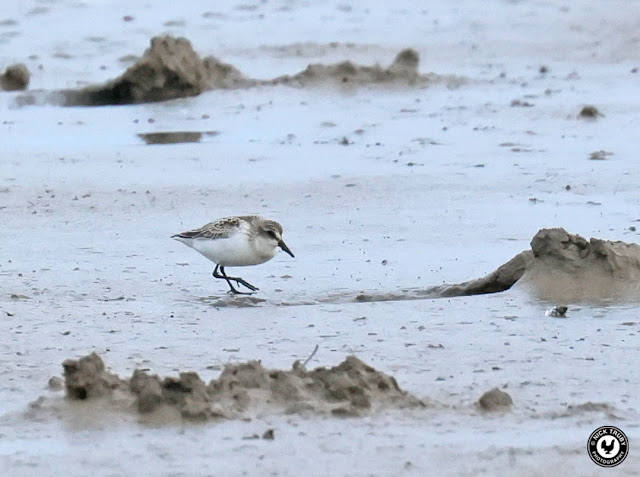


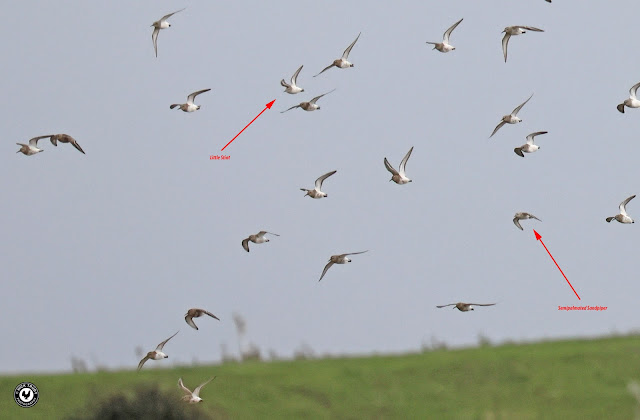















































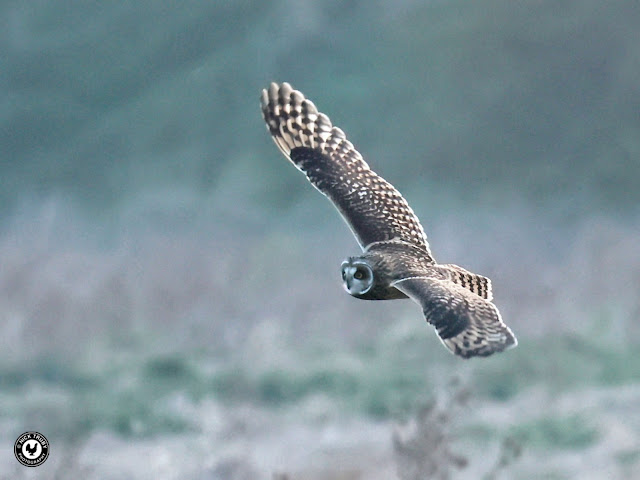






No comments:
Post a Comment